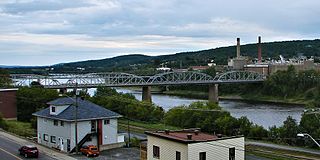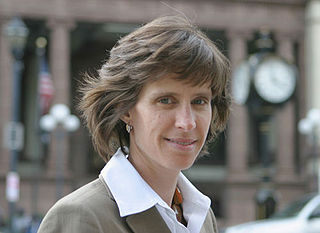Grid computing is the use of widely distributed computer resources to reach a common goal. A computing grid can be thought of as a distributed system with non-interactive workloads that involve many files. Grid computing is distinguished from conventional high-performance computing systems such as cluster computing in that grid computers have each node set to perform a different task/application. Grid computers also tend to be more heterogeneous and geographically dispersed than cluster computers. Although a single grid can be dedicated to a particular application, commonly a grid is used for a variety of purposes. Grids are often constructed with general-purpose grid middleware software libraries. Grid sizes can be quite large.
RAID is a data storage virtualization technology that combines multiple physical disk drive components into one or more logical units for the purposes of data redundancy, performance improvement, or both. This is in contrast to the previous concept of highly reliable mainframe disk drives referred to as "single large expensive disk" (SLED).

Second Life is an online video game that allows people to create an avatar for themselves and then interact with other users and user-created content within a multi-user online virtual world. Developed and owned by the San Francisco–based firm Linden Lab and launched on June 23, 2003, it saw rapid growth for some years and in 2013 it had approximately one million regular users. Growth eventually stabilized, and by the end of 2017 the active user count had declined to "between 800,000 and 900,000". In many ways, Second Life is similar to massively multiplayer online role-playing games; nevertheless, Linden Lab is emphatic that their creation is not a game: "There is no manufactured conflict, no set objective."

World Community Grid (WCG) is an effort to create the world's largest volunteer computing platform to tackle scientific research that benefits humanity. Launched on November 16, 2004, with proprietary Grid MP client from United Devices and adding support for Berkeley Open Infrastructure for Network Computing (BOINC) in 2005, World Community Grid eventually discontinued the Grid MP client and consolidated on the BOINC platform in 2008. In September 2021, it was announced that IBM transferred ownership to the Krembil Research Institute of University Health Network in Toronto, Ontario.

The State Grid Corporation of China (SGCC), commonly known as the State Grid, is a Chinese state-owned electric utility corporation. It is the largest utility company in the world. As of March 2024, State Grid is the world's fourth largest company overall by revenue, behind Walmart, Saudi Aramco, and Amazon. In 2022 it was reported as having 871,145 employees, 1.1 billion customers and revenue equivalent to US$460 billion. It is overseen by the State-owned Assets Supervision and Administration Commission of the State Council.

Vehicle-to-grid (V2G) describes a system in which plug-in electric vehicles (PEVs) sell demand response services to the grid. Demand services are either delivering electricity to the grid or reducing the rate of charge from the grid. Demand services reduce the peaks in demand for grid supply, and hence reduce the probability of disruption from load variations. Vehicle-to-load (V2L) and Vehicle-to-vehicle (V2V) are related, but the AC phase is not synchronised with the grid, so the power is only available to "off-grid" load.

The Toyota Innova is a series of multi-purpose vehicles (MPV) manufactured by the Japanese carmaker Toyota since 2004, mainly sold with three-row seating.

The Edmundston–Madawaska Bridge is an international bridge which connects the cities of Edmundston, New Brunswick, in Canada and Madawaska, Maine, in the United States, across the Saint John River. The bridge consists of four steel through truss spans, each 70.71 metres (232.0 ft) in length, for a total length of 287.12 metres (942.0 ft), which carries a two lane open steel grid deck roadway.

Dawn Zimmer is an American politician who served as the 38th mayor of Hoboken, New Jersey. As president of the Hoboken City Council, she became acting mayor after incumbent Peter Cammarano's resignation on July 31, 2009 following his arrest on corruption charges. Zimmer is the first female mayor of Hoboken. She was first elected mayor in a special election for the balance of Cammarano's term on November 6, 2009 and was re-elected mayor for another four-year term in November 2013. In 2012, 2013 and 2014, she was ranked #3, #4 and #5, respectively, on The Hudson Reporter's list of the 50 most influential people in Hudson County.
Twilio Inc. is an American cloud communications company based in San Francisco, California, which provides programmable communication tools for making and receiving phone calls, sending and receiving text messages, and performing other communication functions using its web service APIs.
Niagara Mohawk Power Corporation was a New York State utility company, which was acquired in 2000 by National Grid plc. The Niagara Mohawk Power Corporation designation was retired, using variations of NationalGridUS, though its official designation on annual reports is still Niagara Mohawk Power Corporation.

Zorin OS is a Linux distribution based on Ubuntu with both free and paid versions. It uses a GNOME 3 and XFCE 4 desktop environment by default, although the desktop is heavily customized for users more familiar with Windows and macOS.

Cortlandt Street is a west-east street in the Financial District of Lower Manhattan, New York City. It runs one block from Broadway to Church Street, then continues an additional block as the non-vehicular Cortlandt Way from Church to Greenwich Street. At its eastern end, the street continues as Maiden Lane.

The Canopy by Hilton Portland Pearl District is a 10-story hotel operated by Hilton Worldwide's Canopy by Hilton brand in Portland, Oregon's Pearl District.









